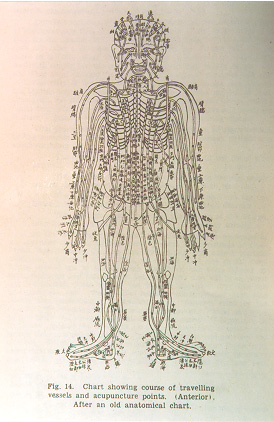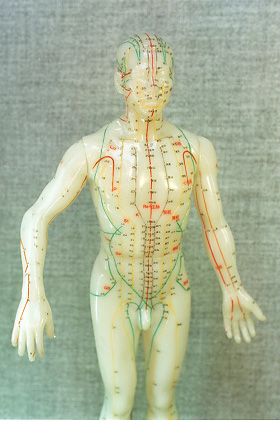The Electrodermal Screening Test
According to traditional Chinese medicine, a form of bodily energy called chi is generated in internal organs and circulates throughout the body, forming paths near the surface of the skin called meridians. This whole-body network is called the meridian system.

Figure 1.: A traditional diagram of the meridians along on the front of the body.

Figure 2. : A modern "acupuncture doll."
Acupuncture points are points on the skin, usually located on meridians, where the circulation of chi can be manipulated.
By stimulating an acupuncture point on the skin through pressure, suction, heat, or needle insertion, the circulation of chi is affected, which in turn affects related internal organs. But this is not the only way to take advantage of the meridian system. The meridian energy flow also carries with it information about internal organs that can be used in diagnosis. This is the basis of the electrodermal screening test (EDST). The device used in the EDST is the electrodermal screening device, or EDSD, which works by measuring electrical resistance and polarization at acupuncture points and meridians. Through these safe, skin-level measurements, it is possible to analyze the bio-energy and bio-information produced by internal organs and systems.
The predecessors to the EDST and EDSD were invented in the 1950's by the German doctor Reinhold Voll whose name is given to another title of this treatment modality, EAV or Electro Acupuncture According to Voll. Dr. Voll originally developed a system of acupuncture point electro-therapeutics, but he soon discovered that when an internal organ's function or structure changes, the performance of the related meridian and acupuncture points also changed, and that this change could be measured using a device. Voll used a device called the Dermatron, but all similar devices can be used for diagnosis and medicine testing. The core of the EDSD is an ohm meter designed to deliver approximately 10-12 microamperes of direct electrical current at 1-1.25 volts, a very small and perfectly safe amount of energy. On the majority of the devices the meter is calibrated to read from 0 to 100 such that the standard skin resistance of 100 kilo-ohms reads 50.

Measuring electrical resistance on a acupoint using the EDSD.
There are two cables coming out of the EDSD, one positive and one negative. The positive lead is attached to a stylus with an electrode tip. The doctor holds the stylus by the insulated handle and presses the tip against one of the patient's acupuncture points. The patient holds a hand electrode in their free hand. During the measurement the patient and the EDSD form a closed circuit, allowing energy and information to flow from the EDSD to the probe, through the patient to the hand electrode, and back to the EDSD. The EDSD reading is a measurement of how much energy makes it through the circuit (the lower the resistance the higher the reading). A reading taken with the EDSD is usually described using two values, the initial reading (generally the highest value) and the indicator drop (ID). An initial reading of approximately 50 followed by little or no indicator drop is considered "good". Initial readings below 45 or above 60 and substantial IDs are all considered bad signs. After the initial stimulus (the initial reading) two things occur: cells become polarized, which increases resistance, and the affected cells work to maintain their natural, unpolarized state. An ID is the result of the polarization of cells that are weakened and can not maintain there own balance.